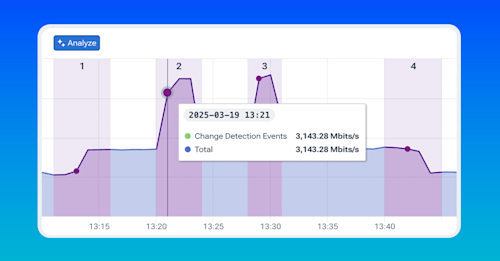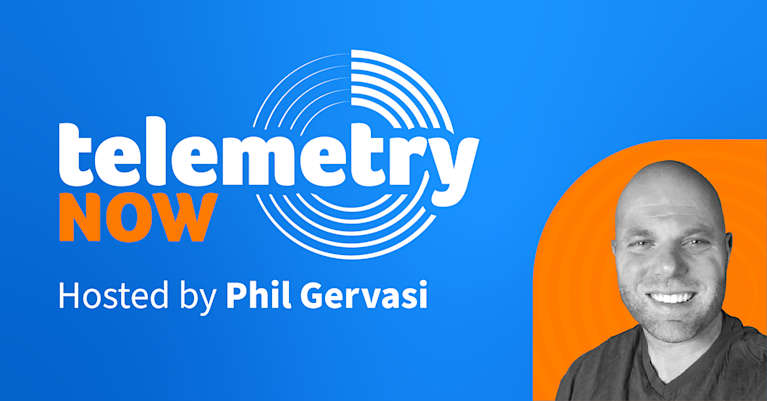From Observability to Network Intelligence: How Kentik Built the Foundation for Networks That Think

Summary
The age of dashboards is ending, as observability has only created more noise for network teams to sift through. Kentik SVP of Product, Mav Turner, lays out why true network intelligence requires a clean, contextual data foundation to finally create a network that thinks.
For as long as networks have existed, we’ve all been chasing the same goal: to really understand them. Not just to see what’s happening, but to know why it’s happening and what to do about it.
But getting there has always been harder than it sounds. Networks generate an enormous amount of telemetry, logs, and metrics — more than any team could ever hope to sift through manually, even when networks were reasonably simple. Today, they’re anything but. Modern user and business demands and the technologies that support them have created a paradigm where networks have never been more critical or more challenging to manage.
For years, the industry’s answer was to build more dashboards, more integrations, more visualizations, more observability (we are as guilty of this as everyone else). But now there is a new way.
This is the story of how observability becomes network intelligence and how Kentik’s data-first approach has been pointing there all along.
The industry’s misstep: Useful data isn’t enough
Over the past decade, the industry’s answer to “too much data” was to make the data more usable. Dashboards! Single panes of glass! Integrations! Correlation engines that promised to reduce noise by 10x! These things were helpful to an extent, but the data we collect has outgrown even these tools. Cutting tens of thousands of events and alerts to a few thousand is still too much to ever look at it and say, “Ahh! There’s the issue!”
So here we were, surrounded by beautiful graphs, color-coded metrics, and integrations, but still feeling like we were treading water. Worse, even as we struggled to stay afloat, we added (pardon the pun) new flows of data, connecting more tools, adding more sources, pulling in more data, convincing ourselves that one more integration will solve things.
It was a wicked paradox: The more usable we tried to make data, the more of it we tried to use. We collected more data, with more integrations, with more visualizations. We didn’t solve the flood; we expanded it. You see, while we were struggling to keep our heads above water, even while keeping the floodgates open, we failed to see that the problem was never about visibility or collection. It was about structure and logic in the first place. We needed data that was enriched, contextual, and that could actually tell us something, not just show us everything.
Kentik’s advantage: Structured for intelligence
Going back to Kentik’s founding, we’ve always felt that data without context is just noise. That’s why we built our data model to ingest and enrich data with meaningful context. Sure, we let you build dashboards and reports. But Kentik’s core was always about querying the hardest types of network data for the hardest types of insights. And because we do the cleaning, normalization, and enrichment at ingest in a highly scalable and efficient data engine, it stays way more performant than other solutions on the market. That itself was enough to make us the industry leader in flow analysis. But in doing so, we also created something better.
It turns out that this highly enriched, structured, contextualized, performant data engine is exactly the kind of semantically rich foundation modern AI systems need. While LLMs excel at interpreting unstructured language, they reason far more effectively when connected to structured, contextual data that reflects real-world relationships — the kind of enriched telemetry Kentik has been building.
From observability to network intelligence
For years, Kentik has been recognized as a network observability company, dedicated to providing network practitioners with deep visibility into their data for informed decision-making. However, recent advancements in LLMs and agentic reasoning have allowed us to begin realizing the next evolution of this vision. We are now moving beyond observability to offer a holistic path to network intelligence.
The key distinction lies in the objective and how far the platform can take you. While observability tools answer “what is happening,” network intelligence platforms go further. They not only identify “what is happening” but also explain “why it’s happening,” assess its “impact,” and suggest “what to do next.” Answers to these questions are integrated into a platform that supports decision-making, rather than simply offering data utility. It’s the difference between knowing an interface has high utilization and knowing what traffic is causing it, and whether specific traffic needs to be rerouted or blocked altogether.
Ultimately, network intelligence has always been the aspiration of network teams. That is, not just having the data to analyze, but instead having the actual power to design, operate, and protect their networks as vital business assets. The challenge has been that the sheer scale and complexity of modern networks have long outpaced our ability to achieve good network intelligence. For the first time, LLMs and AI are advanced enough to help us regain control and realize this long-sought objective.
The next chapter: What comes after data
Kentik’s vision as a network intelligence company isn’t just adding a chatbot on top of your NMS (though to be fair, this was one of our earliest forays into the AI world). It’s about enabling systems to reason with full contextual understanding of your network in much the same way experienced engineers do to design, operate, and protect networks.
The next evolution of our platform will introduce an intelligent system that reasons, contextualizes, and recommends, powered entirely by the data architecture we’ve spent a decade perfecting. It will work alongside operators, not instead of them, amplifying expertise, compressing time to insight, and making complex analysis as simple as asking a question.
Kentik’s data foundation enables this thanks to the complete, enriched picture of the network our platform provides. By combining foundational LLM knowledge (what we humans might consider academic knowledge) with real-world telemetry and the deep operational insights and best practices gathered from the world’s most sophisticated network operators (what we humans call intuition and experience), we can teach machines to reason like network experts—only faster, more consistently, and at scale. The foundation we built for network observability has become the platform for network intelligence.
The age of dashboards is ending. We’ve spent years engineering the most complete, contextual, and performant network data model in the world. Kentik is the only one with the visibility and data to bring you those insights. Network intelligence is here, and we can’t wait for you to see it.



